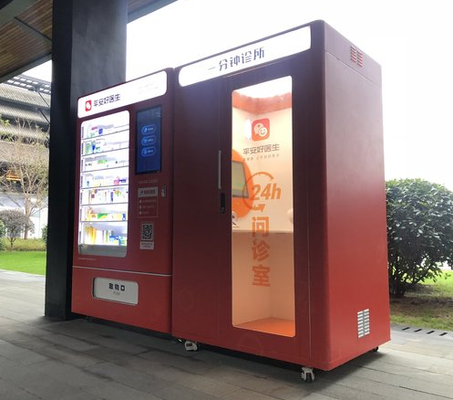
By Dave Wieneke -
Ping An is China’s second-largest life and property & casualty insurer. In the next sixty days, they plan to open 1,000 clinics, with none having on-site staff. This is just two months from the debut of their staffless medical clinic and pharmacy at the Wuzhen World Internet Conference which took place this November.
Opening an average of over thirty points of presence a day for two months sounds crazily ambitious, especially for from a payer organization. But there’s little about Ping An which isn’t that way. The three-year old company currently serves 50 million Chinese patients a month through its app Ping An Doctor. They’ve demonstrated an ability to reach and serve millions of healthcare consumers at-scale; now they’re inventing automated points of service.
Patients enter an “Independent Advisory Room” which is about the size of a phone booth. They receive a virtual consultation starting with an assessment by Ping An’s Artificial Intelligence enabled Doctor software. Information gathered from the assessment helps initiate a telemedicine session with the right human physician who makes the diagnosis and interacts with the patient.
The Advisory room has an attached Smart Medicine Cabinet vending machine, which stocks over 100 medications on site. If other medications are needed, they can be purchased through the Ping An app and delivered to patients in the areas served by these facilities in just an hour.
That’s a pretty huge change from the doctor office visit that most clinicians were trained to perform in medical school, which makes Ping An’s experience as an app invaluable. Having concluded 300 million patient visits by app, they have data resources that provide the company’s 1,000 doctor team an empirical basis for providing better advice remotely.
The potential for leveraging patient and member data makes Ping An’s solution extra intriguing. You see, provider organizations tend to own a lot of the patient relationship, but payer organizations have an unparalleled view of clinical activity and cost. Ping An’s ability to join millions of clinical treatment episodes to a comprehensive view of clinical activity presents an opportunity for improvement and discovery.
Naturally, every culture decides how medicine may be practiced in it. This kind of innovation opens up the kind of questions that may be seen differently in different cultural contexts. Consider, “optimization” which sounds benign and tech-led, but it could easily stray in to ad hoc human research.
Cultures take differing views on the kinds patient data payers should be allowed to keep or use to restrict information or access to treatment through price discrimination. Different privacy regimes may require anonymized data to forgotten or opened-up for public use after some amount of time.
Healthcare is likely one of the most complex and complicated sectors that AI and automation can be applied. A massive network of unstaffed doctor booths carries more complexity than more mercantile endeavors. So, since this even happening in healthcare, this might be a smart time for more traditional businesses to consider ways these tools and processes can open-up change.
This showroom in Jalan Kilang, in Bukit Merah, Malaysia is hailed as the world’s largest “vending machine” for cars.

We’ve pretty much accepted shifting humans out of selling access to highways, mass transit systems and ski resorts with the combination of smart objects and system automation.
Might we mix remix experiences in senior care, fitness clubs, or in retail settings where something like Amazon Go could facilitate useful interactions mixing human and artificial intelligence inputs? How about selling real estate, or talking about why an investment plan is suitable? As you think about the ways customer experience can change in the new year, this combination of remote interaction, automated systems and machine learning can get teams thinking on ways to increase the convenience and accessibility of their services to wider audiences.
The leaders our teams at Connective DX are working with in healthcare are already using such approaches to improve diagnosis and to mix machine and human interaction in new ways to richer provider and patient experiences.
I’ll write more about this in the new year. But for now, when you think of healthcare innovation (for good or ill) imagine it on a scale of 50 million visits a month in facilities where no doctor is present.
That’s Ping An’s idea for innovation in 2019. What’s yours?
Concentrix Catalyst is the experience design and engineering team of Concentrix, a leading global solutions company that reimagines everything CX through strategy, talent, and technology. We combin... Read more
We’ve all heard the hype around digital transformation: it seems everyone wants to talk about it. But just because there’s a lot of hype doesn’t mean it’s not ...read more
While nothing can replace face-to-face communication, especially when it comes to teamwork, COVID-19 is forcing most organizations to rethink how they’re going to conduct planning ...read more
Derek Phillips, Director of Content Strategy at PK, and I take a spin through COVID websites as hospitals evolve how they respond to the pandemic. We discuss both their merits and ...read more
Strategy, systems and support enable better patient experiencesOregon Health & Science University holds a world-renowned reputation for leadership in healthcare, academic, and ...read more